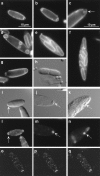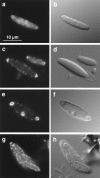Propagation by sporulation in the guinea pig symbiont Metabacterium polyspora
- PMID: 9707627
- PMCID: PMC21488
- DOI: 10.1073/pnas.95.17.10218
Propagation by sporulation in the guinea pig symbiont Metabacterium polyspora
Abstract
The Gram-positive bacterium Metabacterium polyspora is an uncultivated symbiont of the guinea pig gastrointestinal tract. Here we present evidence that in M. polyspora vegetative cell division has taken on a minor, and apparently dispensable, role in propagation. Instead, this unusual bacterium has evolved the capacity to produce progeny in the form of multiple endospores. Endospore formation is coordinated with transit of the bacterium through the gastrointestinal tract of the guinea pig. For the majority of cells, sporulation is initiated in the ileum, whereas later stages of development take place in the cecum. We show that multiple endospores are generated both by asymmetric division at both poles of the cell and by symmetric division of the endospores at an early stage of their development. Our findings suggest that M. polyspora represents an intermediate step in the evolution of a novel mode of cellular propagation that originates with endospore-forming Bacillus and Clostridium spp., which reproduce by binary fission, and extends to Epulopiscium spp., which create multiple viviparous offspring by a process of internal reproduction.
Figures




References
Publication types
MeSH terms
Substances
Associated data
- Actions
- Actions
- Actions
Grants and funding
LinkOut - more resources
Full Text Sources
Miscellaneous

